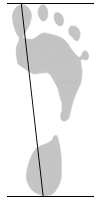No products in the cart.

Measure Your Feet
Your feet change during your lifetime. To make sure that you get the best possible fit and comfort, we suggest you follow the simple directions below each time you purchase new shoes. To obtain the most accurate measurement, have someone else mark your feet for you so that you are standing up straight, full weight-bearing. Your feet likely won’t fit on a standard sized piece of paper, use a larger piece, or tape two pieces together.
- Place a piece of blank paper on a hard floor.
- Stand on the paper wearing a sock of medium thickness.
- Holding a pencil vertically, place a mark at the end of your heel.
- Place another mark at the tip of your longest toe.
- Mark the sides of your foot at the widest part.
- Measure your other foot using the same method.
- To find your size, measure the heel-to-toe mark and use the inch-to-size table. For example, if you are a man and your foot measures 12″ long, you will wear a U.S. size 14 shoe.
- To find your width, measure the marks for the widest part of your foot and use the inch-to-size table. For example, if you are a man with a U.S. size 14 length and your width measures 4-8/16″, you will wear a medium width (D) shoe.
- If your measurements are between two sizes, or you find one foot’s measurement larger than the other, always move up to the larger size.
- If swelling is an issue you may also wish to measure your foot girth. Girth is measured all the away around your foot and can be measured at the instep (instep girth) and/or at the ball of your feet (foot ball girth). You can call us with these measurements and we can help fit you into our therapeutic shoes which are designed to accommodate swelling and edema.
